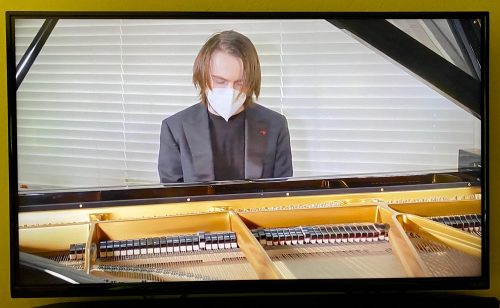 United States Bach, The Art of Fugue: Daniil Trifonov (piano), presented virtually by Aspen Music Festival, streaming from Connecticut, 19.7.2020. (HS)
United States Bach, The Art of Fugue: Daniil Trifonov (piano), presented virtually by Aspen Music Festival, streaming from Connecticut, 19.7.2020. (HS)

Pianist Daniil Trifonov does not shy away from big challenges. For his recital at last summer’s Aspen Music Festival he strung together piano works representing each decade of the twentieth century into a marathon exploration of modern classical pianism. For the festival’s virtual concert Sunday, streamed from Trifonov’s home in Connecticut, the Russian-born pianist tackled The Art of Fugue, which J. S. Bach left unfinished at his death in 1750. Over a 10-year period, history’s greatest counterpoint composer spun a singular strand of melodic material into an hour-long tapestry that summed up everything he knew about the fugue.
Finding the piece’s depths poses quite a test for a pianist who has not yet reached his 30th birthday. Trifonov not only prevailed but put his own stamp on the music. He focused on bringing out its lyrical soul without compromising the necessary rhythmic pulse or the Baroque fugue’s strict architecture. He also offered a completion of Bach’s work by writing his own ending for the finale, and it’s a good one.
This performance omitted the four canons, which can provide breathers between groups of related fugues. If this raised the level of difficulty, Trifonov found ways to achieve variety.
At his Fazioli grand piano, set up in a corner of his living room before a backdrop of white Venetian blinds, Trifonov applied a tenderness and sweetness to the first four fugues, even introducing some gentle rubato to allow phrases to breathe. The fourth picked up the pace with a soft lilt balanced against crisp attacks as phrases emerged from the counterpoint, and the fifth settled into an introspective quiet.
The sixth, ‘In a French Style’, stepped out boldly with stentorian octaves, kept to a steady tempo and introduced some pedal to produce bigger sounds. Even as the key stayed in D minor, Trifonov found colors for the succeeding fugues – lively and bright in the ninth, melancholy in the tenth, building from a quiet hush to a plateau of richness in number 11.
In the next two, the contrasts felt like turning a corner from a slow, dreamy 12th to dancing in the sunlight with the triplets of the 13th. Actually, these are two fugues each, as Bach turns the material of each fugue upside down for a second go. With tempo and touch, using pedal judiciously, the pianist conjured different emotional effects with each one.
In the extensive, final triple fugue Bach went against expectations by aiming for quiet contemplation rather than revving up for a big finish. It goes on for longer than most of the other fugues, even though Bach left it unfinished at the point where it introduces a new figure, a four-note sequence that spells out ‘B-A-C-H’.
Several composers have taken a shot at writing a finish, often picking up the figure and running with it in their own styles. Trifonov, a composer in his own right, opted to stick to Bach’s rules of fugue writing. His finish is not at all showy. It summons a kind of serene beauty, and lets the music unfold gently until it reaches a sigh of a finish.
If you missed the Sunday broadcast, it’s repeated once tonight (Tuesday) at 7pm. MDT, accessed via the Aspen Music Festival web site (click here), YouTube channel, or Facebook page.
Harvey Steiman
